


Commoner in winter than in summer. Can been seen in flocks on a couple of hundred in places such as Hoveringham and Attenborough, although numbers have dropped a bit in the past decade. Always seems to be asleep. Had to prod the one in the photo to wake it up. Prefers shallow water to feed, and has a preference for vegetable material rather than animal.
It is a rare breeding duck in Nottinghamshire with just a handful of broods a year, preferring waters with more luxurious vegetation than the average worked out gravel pits.
Probably a lot commoner now than in the nineteenth century, the growth in gravel pits may have aided the wintering numbers of this bird.
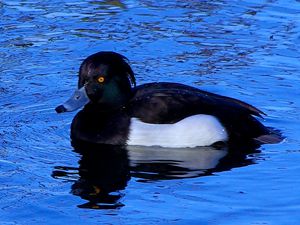
Much commoner in winter than in summer, a few pairs breed. The wintering birds arrive in September and swell the breeding population many times. It is at home on large open pits in the winter, but prefers quieter, more secluded areas for breeding.
The peak numbers usually occur in December and January, but is obviously dependant on the weather. Hard frosts cause the icing over of Nottinghamshire's Lakes and gravel pits and as with other waterfowl, drive the birds onto the River Trent. The winter visitors eventually leave us in late March and April. Has greatly benefited from the growth in gravel pits.
Originally in the mid–nineteenth century, according to Whitaker's List of the Birds of Nottinghamshire {1879}, the ducks only bred in the forest area of Nottinghamshire, that is from Annesley/Newstead northwards to Rufford and Osberton. The seasonal pattern of the Tufted Duck seems the same than as now, large flocks in the winter, with a few staying to breed.
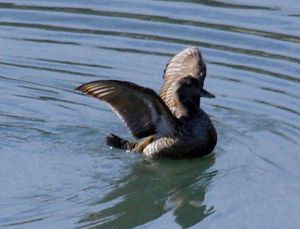
The Eider is a rare visitor to Nottinghamshire, like the Long-tailed Duck below, it is a sea duck and only lost or stressed birds come our way. Practically all the Nottinghamshire birds were found in the Trent Valley.
Neither Sterland or Whitaker mention it in their List of the Birds of Nottinghamshire {1879}. However Dobbs in The Birds of Nottinghamshire {Dobbs,1975} mentions one shot in Nottingham in either 1878 or 1880.
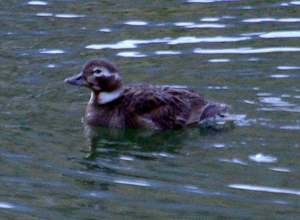
Certainly a scarce, usually winter, visitor to Nottinghamshire. The Long-tailed Duck is mainly a sea duck and hence the records for Nottinghamshire are only of lost singletons.
Sterland only mentions one record in his List of the Birds of Nottinghamshire {1879}
Presently Long-tailed Ducks visit Nottinghamshire at an average of about one per year.
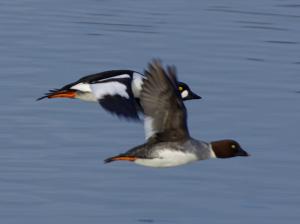
The Goldeneye is a fairly common winter visitor to Nottinghamshire with the old gravel workings such as Hoveringham, Holme Pierrepont and Lound having the highest numbers. Numbers in the winter have increased from c20 birds in the mid-twentieth century to over 300 birds in the early twentyfirst.
Nottinghamshire's birds are considered to come from Scandinavia and west Russia – much like the rest of Britain's wintering population.
According to Sterland and Whitaker in the "Descriptive list of the birds of Nottinghamshire {1879}" it occurred every winter in the mid-ninetenth century.
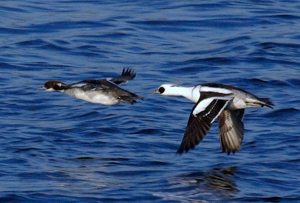
The Smew is a uncommon visitor to Nottinghamshire – its main site is the Holme Pierrepont/Colwick park area which often hold 3 or 4 birds in the winter. It tolerates smaller areas of water, such as the finger ponds at Holme Pierrepont and the Hall lake at Colwick, than its Goldeneye and Goosander relatives. Female birds ‘red-heads’ are more often seen, as the white males winter closer to the breeding territories in north Finland and Russia. Numbers are higher when the weather is colder in the Netherlands.
Its status in Nottinghamshire has probably not changed much since Sterland in "A Descriptive list of the birds of Nottinghamshire {1879}" stated that it was seen most winters in small numbers at Thoresby and on the river Trent in the winter.
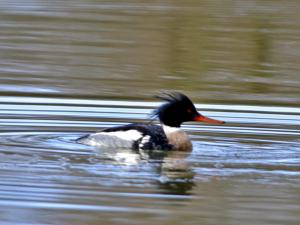
The Red-breasted Merganser is a scarce winter visitor to Nottinghamshire. It occurs most years with December, January and February being the months with the most occurrences. Sterland, in the "Descriptive list of the birds of Nottinghamshire {1879}", mentioned that it was ‘occasionally seen in winter on the Trent’.
Sometimes because of hard weather there are large influxes, such as in 1979.
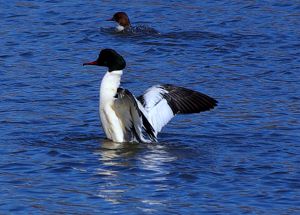
A regular winter visitor Goosanders are not very often in flocks larger than a score or so. Can be found in the winter in the usual places such as Attenborough, Hoveringham, Welbeck Lake, Clumber Lake and Lound.
Sterland in his "Descriptive list of the birds of Nottinghamshire {1879}" said that these were a regular visitor in the nineteenth century to the Dukery Lakes, Newstead Lakes and the river Trent. He once had a count of 43 on Thoresby Lake.
Incidentally, a gathering of Goosanders is called a dopping of Goosanders.
Any criticisms, corrections or comments to the author Derek Huskisson

This work is licensed under a Creative Commons Attribution-Noncommercial-Share Alike 2.0 UK: England & Wales License.